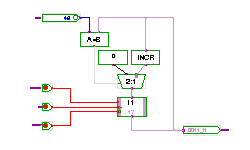

This is the home page for HADES, the Hamburg Design System, an object-oriented and WWW-enabled simulation framework based on the Java language.
Our first application of HADES is to system-simulation and HW/SW-cosimulation of digital circuits and systems. However, because all simulation models, all signal types, and the simulation engine itself can be subclassed, almost every aspect of HADES can be adapted to specific needs. For example, see a simple image-processing application realized in HADES. Also, via its own special class loader, HADES is able to locate and load simulation models and accompanying software both from the local file system or the WWW.


- user friendly interface
- fully interactive simulation - no recompilation after changes to the setup
- comlete model libraries available
- scripting via JPython
- WWW-enabled design and library browser
- interactive component property editors
- flexible waveform viewer
- full access to the simulation engine
- full access to all Java class libraries
- full access to the underlying JavaFIG graphics editor
- high-quality export of schematics, e.g. to Postscript
- basic and complex logic gates
- all flipflops
- 74xx series models
- flexible and animated I/O components
- full library of generic n-bit RT level components
- memory components
- system-level components (VT100, DCF77-transmitter, LC-displays, ...)
- embedded processors for HW/SW-cosimulation
- debugging and measurement utilities and components
- VHDL export, e.g. to Synopsys and Maxplus2
For example, the HADES model library includes a simulation model of the VT52/VT100 terminal with its own user interface and a fully-configurable RS232 communication interface. Never again you will have to debug your serial communication circuits and programs by looking at the bit-patterns in the waveform display...
Another example are the image-processing operators and filters in the "hades.models.imaging" package and sub-packages. When writing an image-processing application, simply watch the input and output data interactively during the simulation, instead of using post-mortem analysis with external viewers after a batch-mode simulation run.
cosimulation
We hope to release both architectural and RT-level simulation models for the Mips R3xxx processor family later this year, ready to run the ECOS-1.1 operating system and tools.
Depending on your browser's security settings, however, the HADES applet may not be able to access files on your local system. In this case, it can access input files and simulation models via the HTTP-protocol from the applet WWW-server only. Also, note that HADES requires the Swing/JFC class libraries.
Unfortunately, neither Netscape Navigator (including version 4.7) nor Microsoft Internet Explorer (4.x, 5.x) are fully Java 1.1 compatible yet. Therefore, you may experience problems running HADES in the popular browsers.
Note: most of the following files are archives in compressed JAR/ZIP-format (extension ".zip"). Please make sure to download these files in binary mode, e.g. in Netscape use right-click, select "save link as". To unpack, use a ZIP-format packer like pkzip, WinZip, or JAR. Note that some older versions of the tools sometimes have problems with unpacking JAR-archives (like reporting zero-length files or unpacking directories without read attributes).
- HADES class archive (all required classes in a signed JAR/ZIP archive). installation (README)
- HADES design examples (several low-to-medium-complexity design examples). More design examples are available on request.
- HADES documentation archive (tutorial and additional HTML docs)
- HADES class documentation (javadoc-generated class documentation for the HADES editor, simulator, models, and the JavaFIG graphics editor framework)
- HADES tutorial (short tutorial covering concepts, installation, basic commands, and an introduction to writing your own simulation models, PDF format)
- HADES class
documentation (javadoc-generated class documentation).
- T-Praktikum (exercses for our lab-course accompanying the basic lectures on digital systems and computer architecture)
- B-Tutorium (exercises and solutions for our tutorial on digital logic, gzip compressed Postscript, in German).